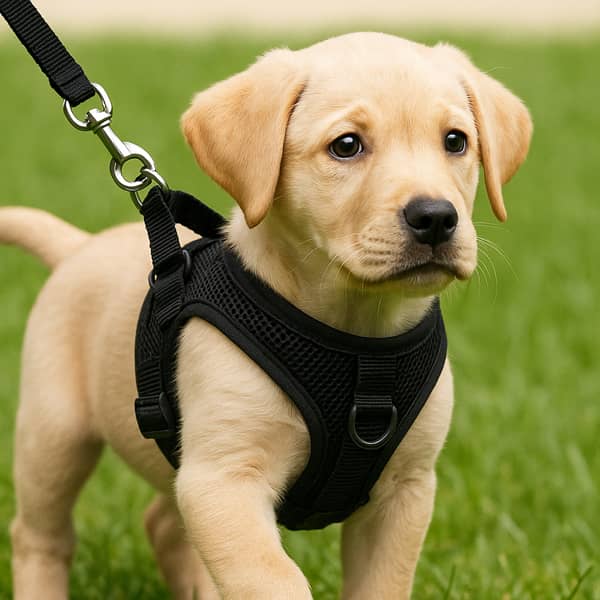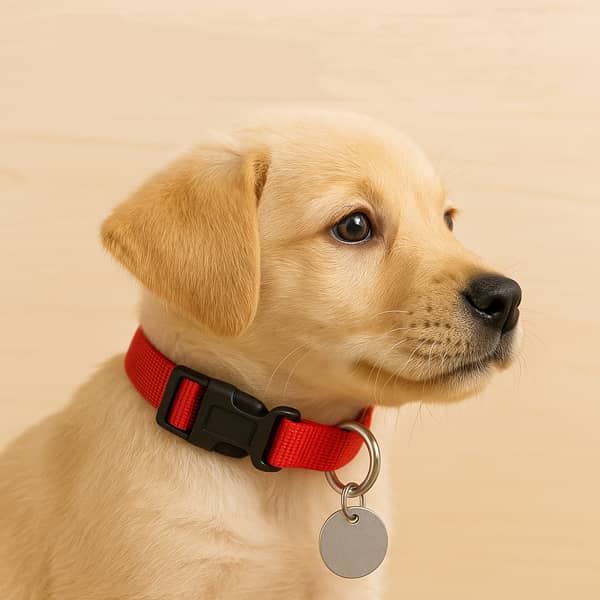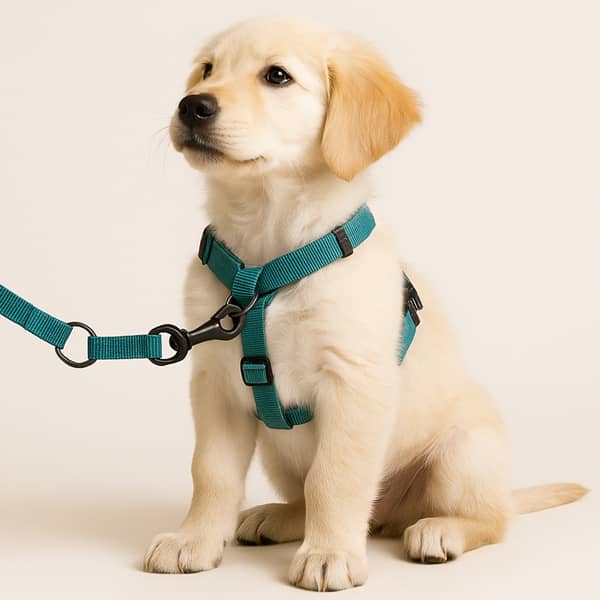Quick Look: Harness vs Collar for Puppies
| Feature | Harness | Collar |
|---|---|---|
| Safety | Safer, less neck strain | Can hurt neck if puppy pulls |
| Comfort | Comfy if fitted right | Simple but can pinch |
| Training | Great control | Okay for calm puppies |
Choosing between a dog harness and a collar for your puppy is super important. It affects how safe they are, how comfy they feel, and how well they learn to walk on a leash. At Bestone Inc., we’re here to help you figure it out with this easy guide. A collar goes around your puppy’s neck and holds ID tags. A harness wraps around their body, spreading pressure across their chest and back. Both can work, but one might be better for your little pup. Let’s find out which!
Introduction to Dog Harnesses and Collars
Puppies are full of energy and love to explore. Giving them the right gear keeps them safe and happy during walks. Collars are simple and have been used forever, but harnesses are becoming more popular, especially for young dogs. This article breaks down the differences so you can pick what’s best for your furry friend.
What is a Dog Collar?
A dog collar is a band that goes around your puppy’s neck. It’s perfect for attaching a leash or ID tags with your phone number. Collars are quick to put on, making them handy for short trips outside. But if your puppy pulls hard, a collar might press on their neck too much. That’s something to think about, especially for little dogs still growing.
What is a Dog Harness?
A dog harness fits around your puppy’s chest and back, not just their neck. It spreads out the pressure when they pull, which can be safer. Harnesses are awesome for training and walking because they give you more control. There are lots of types, like front-clip or back-clip ones. Curious about the options? See this list of harness types for more info.
Why This Matters for Puppies
Puppies aren’t fully grown yet, so their necks and spines are delicate. Using the wrong gear could hurt them or make walks stressful. Harnesses and collars each have pros and cons, and picking the right one depends on your puppy’s needs. In this article, we’ll cover safety, comfort, training, and health to help you decide.
According to the American Kennel Club, “Harnesses are ideal for dogs that pull, preventing neck strain.” This is a big deal for puppies learning to walk nicely.
Why Pet Owners Need to Know
New pet owners might wonder why this choice is such a big deal. Well, it’s all about keeping your puppy safe and comfy while they grow. Plus, the pet gear market is huge—worth over $5 billion in 2023 and growing fast! Knowing what works best helps you avoid mistakes and enjoy walks with your pup.
The global dog collars, leashes, and harnesses market is expected to hit USD 9.51 billion by 2030, growing at 8.2% per year, says Persistence Market Research. Pet brands are focusing on safety and style, making this topic key for 2024–2025.
Safety Considerations for Puppies
Safety is the number one thing to think about when picking between a harness and a collar. Puppies love to tug and pull, which can be risky if you’re not using the right equipment. Let’s look at why one might be safer than the other.
Why Harnesses Are Safer
Harnesses are generally safer for puppies during leash training. They spread pressure across the chest and back, reducing the risk of tracheal and neck injuries. This is super important because puppies’ necks are still soft and growing. A study from Frontiers in Veterinary Science (2021) showed harnesses cut down neck injury risks a lot compared to collars. For more on how harnesses are made safe, peek at this manufacturing guide.
Risks of Collars for Puppies
Collars can be risky if your puppy pulls a lot. They might strain the trachea—the tube they breathe through—or even choke. This is extra dangerous for small breeds or dogs with short noses, like Pugs or Bulldogs, who already have breathing troubles. Puppies with skinny necks, like Greyhounds, might slip out of collars too, which could let them run off. Collars are great for ID tags.
Expert Opinion on Safety
“Harnesses are safer, as they avoid neck strain and improve control for dogs that pull.” — Dr. Carly Fox, DVM, Animal Medical Center (Business Insider)
Experts like Dr. Fox say harnesses are a smart pick for keeping puppies safe on walks.
What to Watch Out For
Even with harnesses, fit matters. A too-tight harness can rub or hurt, and a too-loose one won’t control your pup well. Collars need to fit right too—not too tight to choke, but not so loose they slip off. Always check the fit as your puppy grows! For tips on measuring, see this guide.
Small breeds and brachycephalic dogs (e.g., Pugs, Bulldogs) are more susceptible to respiratory issues and benefit from harnesses that avoid pressure on the neck. This makes harnesses a top choice for safety-conscious pet owners.



Comfort and Fit: Harness vs Collar
Comfort is a big deal for your puppy. If they’re not comfy, they won’t enjoy walks, and that can make training harder. Both harnesses and collars need to fit just right to keep your pup happy. Let’s see how they compare.
Why Harnesses Can Be More Comfortable
Harnesses spread pressure over your puppy’s chest and back, not just their neck. This means less strain and more comfort, especially for pups that pull. But, if a harness is too tight or too loose, it can rub or cause chafing. A good fit is key! Look for soft padding and adjustable straps.
Collars and Comfort
Collars are simpler and lighter, which some puppies prefer for wearing around the house. They’re easy to put on and take off, making them handy for quick bathroom breaks. But if your puppy pulls, a collar can dig into their neck, which isn’t comfy at all. Collars should be snug but not tight—enough room for one or two fingers to fit underneath. Learn more about collar types at this page.
Proper Fit for Both
Whether you choose a harness or a collar, fit matters. For harnesses, measure your puppy’s chest and neck, and adjust the straps so they’re snug but not tight. Collars should sit high on the neck, not sliding down. Puppies grow fast, so check the fit every few weeks. A bad fit can make your pup uncomfortable or even hurt them. For measuring tips, see this harness measuring guide.
Ill-fitting harnesses may cause discomfort, chafing, or restrict movement; proper fit is essential to ensure safety and comfort. This is why many pet owners prefer harnesses with adjustable straps and soft materials.
Training and Control: Which Works Better?
Training your puppy to walk nicely on a leash is a big step. The right gear can make it easier for both of you. Let’s look at how harnesses and collars help with training and control.
Harnesses for Better Control
Harnesses, especially front-clip ones, give you more control over your puppy’s movements. When they pull, the harness turns them toward you, which stops the pulling without hurting them. This makes training easier and safer. Many trainers recommend harnesses for puppies still learning to walk calmly.
Collars for Basic Training
Collars can work for puppies who don’t pull much. They let you guide your pup’s head, which can help with focus during training. But if your puppy is strong or excitable, a collar might not give you enough control. It could also strain their neck if they tug too hard. Collars are better for pups who already know how to walk nicely.
Expert Tip for Training
“Front-clip harnesses can discourage pulling behavior by redirecting the dog’s movement, making them effective for training purposes.” — Australian Veterinary Association (AVA), 2024
This expert advice shows why harnesses are a top pick for puppy training.
Combining Both for Success
Some pet owners use both a collar and a harness. The collar holds ID tags, and the harness is for walking. This way, you get the best of both worlds. Just make sure your puppy is comfy with both on. For ideas on harness and leash sets, see this page.
Harnesses can provide better control over energetic or reactive puppies, aiding in managing behaviors like lunging or jumping. This makes them a favorite for trainers and pet owners alike.
Health Implications: Neck Strain and More
Your puppy’s health is super important. The wrong gear can cause problems, especially for their neck and spine. Let’s see how harnesses and collars affect their health.
Collars and Neck Strain
Collars can put a lot of pressure on your puppy’s neck if they pull. This might lead to neck strain, tracheal damage, or even thyroid issues. Small breeds and dogs with short noses are at higher risk. A study in Veterinary Medicine and Science (2020) found collars increase the risk of tracheal collapse in small dogs.
Harnesses for Healthier Walks
Harnesses spread pressure across the chest and back, protecting the neck and spine. This is great for puppies still growing. But, if a harness doesn’t fit right, it can restrict movement or cause chafing. Always choose a harness with a good fit and soft materials. For eco-friendly options, check out this sustainable supplies page.
What Vets Say
“Harnesses are ideal for puppies with neck issues or restricted airways, preventing health complications.” — Dr. Travis Arndt, DVM
Vets like Dr. Arndt recommend harnesses for puppies to keep them healthy and happy.
Long-Term Health Benefits
Using a harness can help prevent long-term health problems. It reduces stress on the neck and spine, which is crucial for growing puppies. Plus, it makes walks more enjoyable, encouraging exercise and play.
While harnesses offer safety advantages, consistent training is crucial to address pulling and ensure good leash manners, regardless of the equipment used. This means harnesses are great, but training is still key.
Conclusion: What’s Best for Your Puppy?
After looking at safety, comfort, training, and health, it’s clear that harnesses are usually the better choice for puppies. They’re safer, comfier, and give you more control during walks and training. Collars are still useful for holding ID tags and might work for calm puppies, but they shouldn’t be the main walking tool. In some places, like the UK, you need a collar with ID tags by law, so using both can be smart.
At Bestone Inc., we recommend talking to a vet or trainer to pick the best harness for your puppy’s breed, size, and behavior. A good fit and quality materials make all the difference. Your puppy’s walks should be fun and safe, setting them up for a happy life.
Ready to find the perfect harness for your puppy? Check out our product page for high-quality options. Or, learn more about our customization services to get gear that’s just right for your pup.


